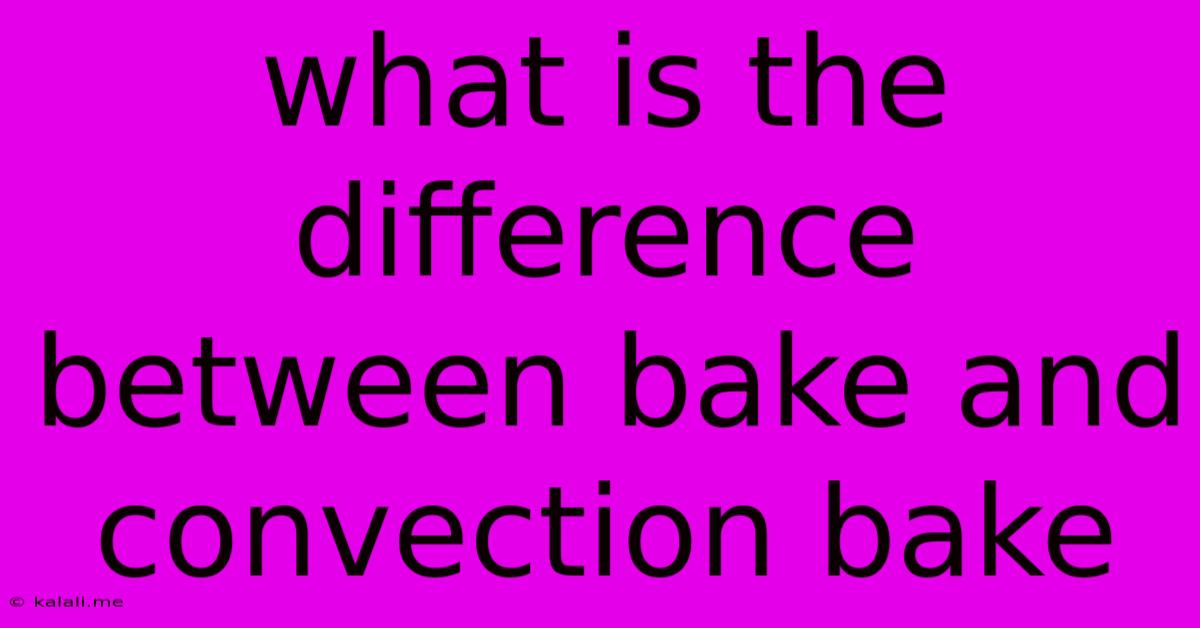What Is The Difference Between Bake And Convection Bake
Kalali
May 31, 2025 · 3 min read

Table of Contents
What's the Difference Between Bake and Convection Bake?
Choosing between "bake" and "convection bake" on your oven can significantly impact the outcome of your culinary creations. This article will delve into the core differences between these two cooking methods, helping you understand when to use each for perfectly baked goods and evenly cooked meals. Understanding these nuances will elevate your baking and roasting game.
What is Baking?
Baking, in its simplest form, utilizes the radiant heat from the oven's heating elements to cook your food. The heat radiates outwards from these elements, typically located at the top and bottom of the oven cavity. This method is familiar to most home cooks and is suitable for a wide range of recipes. However, it often results in uneven cooking, particularly with larger items. You might find that the bottom is browned before the top is cooked through, requiring you to rotate pans and potentially adjust cooking times.
What is Convection Baking?
Convection baking takes the traditional baking method a step further by incorporating a fan. This fan circulates hot air throughout the oven cavity, ensuring even heat distribution. This means your food cooks faster and more evenly, resulting in crispier crusts and perfectly cooked interiors. The constant movement of hot air reduces hot spots within the oven, leading to more consistent browning and preventing undercooked or burnt areas. This method is particularly beneficial for items like cookies, cakes, and roasting vegetables and meats.
Key Differences Summarized:
| Feature | Bake | Convection Bake |
|---|---|---|
| Heat Source | Radiant heat from elements | Radiant heat + fan-circulated air |
| Heat Distribution | Uneven | Even |
| Cooking Time | Longer | Shorter |
| Results | Potentially uneven browning | Even browning, crispier crusts |
| Best For | Simple recipes, smaller items | Large items, even browning required |
When to Use Each Method:
-
Bake: Ideal for simple recipes that don't require precise temperature control, such as some cakes, muffins, and casseroles where slight unevenness is less critical. It's also suitable for foods that benefit from a gentler cooking process, preventing them from drying out too quickly.
-
Convection Bake: This method is best suited for items that require even browning and faster cooking times. This includes roasting large cuts of meat, baking cookies for consistent browning, and creating perfectly crisp-skinned pizzas. Convection baking is particularly efficient when cooking multiple items simultaneously.
Tips for Convection Baking:
-
Adjust Cooking Times: Because convection baking cooks faster, you will likely need to reduce cooking times from standard baking recipes by approximately 25%. Always monitor your food closely.
-
Avoid Overcrowding: Proper airflow is crucial for effective convection baking. Don't overcrowd the oven, allowing ample space between pans for optimal heat circulation.
-
Check Doneness Frequently: The faster cooking time can mean that your food cooks to completion quickly. Check for doneness frequently to avoid overcooking.
Conclusion:
While both baking methods achieve the same end goal – cooking your food – understanding the differences between baking and convection baking will help you master your culinary skills and consistently produce high-quality results. Choosing the right method will result in more predictable and delicious outcomes, no matter what you're cooking. Experiment with both methods and observe the results to find what works best for your recipes and oven.
Latest Posts
Latest Posts
-
Should You Change Up The Main Melody
Jun 02, 2025
-
How To Turn Off Chat In Minecraft
Jun 02, 2025
-
Can You Install 64 Bit Linux On 32 Bit System
Jun 02, 2025
-
What Can You Do With An Invisible Role In Discord
Jun 02, 2025
-
I Drove With My Parking Brake On
Jun 02, 2025
Related Post
Thank you for visiting our website which covers about What Is The Difference Between Bake And Convection Bake . We hope the information provided has been useful to you. Feel free to contact us if you have any questions or need further assistance. See you next time and don't miss to bookmark.